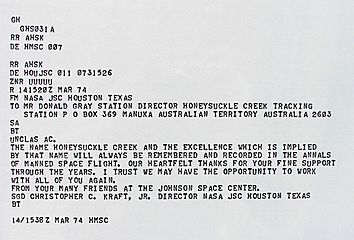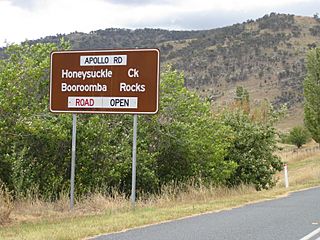Honeysuckle Creek Tracking Station facts for kids
Honeysuckle Creek Tracking Station, often called Honeysuckle Creek, was a special NASA station in Australia. It was located near Canberra and played a super important role in the Apollo Program, which sent humans to the Moon! This station opened in 1967 and closed its doors in 1981.
| Location(s) | Tennent, Australian Capital Territory, AUS |
|---|---|
| Coordinates | 35°35′01″S 148°58′37″E / 35.5836°S 148.977°E |
| Telescope style | ground station |
Contents
A Key Role in Space History
Honeysuckle Creek is famous for a very important moment in history. It was the station that received and sent out the first TV pictures of astronaut Neil Armstrong stepping onto the Moon. This amazing event happened on July 20, 1969.
Besides TV pictures, Honeysuckle Creek also talked to the Apollo spacecraft. It communicated with the Eagle (the part that landed on the Moon) and the Columbia (the part that stayed in orbit). Another station, the Canberra Deep Space Communications Complex (also known as Tidbinbilla), helped with this too.
Many people think the Parkes Observatory (nicknamed Parkes) was the main station for the Moon landing. This was shown in the Australian movie The Dish. However, Parkes only received the footage of the lunar module landing. The famous first steps on the Moon were actually sent from Honeysuckle Creek!
Even though the Parkes antenna was more powerful, its position wasn't right for the first seven minutes of the Moonwalk. Strong winds made it hard for Parkes to get the signal. Honeysuckle Creek's signals went straight to Sydney, Australia, and then were sent worldwide. Charlie Goodman, working for NASA, chose the video feed from Honeysuckle Creek for everyone to see.
How the Station Worked
Both the Honeysuckle Creek and Tidbinbilla antennas were built and run by NASA. But, they were staffed by Australians! The Australian government made sure that the director of the station was always an Australian citizen.
After the Apollo missions finished in 1972, Honeysuckle Creek got a new job. It started working with the Skylab program, which was America's first space station. It also helped with experiments using scientific equipment left on the Moon by astronauts.
In 1974, after the Skylab program ended, Honeysuckle Creek became part of the Deep Space Network. This is a worldwide network of antennas that NASA uses to talk to spacecraft far out in space. Honeysuckle Creek was given the name Deep Space Station 44.
The station closed in December 1981. Its large 26-meter antenna was moved to the nearby Canberra Deep Space Communications Complex at Tidbinbilla. There, it was renamed Deep Space Station 46. This antenna was eventually stopped from being used in late 2009.
In May 2010, the American Institute of Aeronautics and Astronautics called the antenna a Historical Aerospace Site. This means it's a very important part of space history and will stay at Tidbinbilla forever.
Today, if you visit Honeysuckle Creek, you'll only see the concrete foundation where the big antenna once stood. An outdoor display was added in 2001 to tell its story. Honeysuckle Creek is also considered the geographical center of the Australian Capital Territory.
Climate at Honeysuckle Creek
The weather at Honeysuckle Creek is much cooler than in Canberra. This is because it's located much higher up in the mountains. Even so, its highest temperatures are quite warm for its elevation. This is because it's on the eastern side of the Brindabella Range, which protects it from some winds.
On average, Honeysuckle Creek gets about 14 snowy days each year.
Images for kids
See Also
- Apollo 11 missing tapes
- Carnarvon Tracking Station
- Orroral Valley Tracking Station
- OTC Satellite Earth Station Carnarvon
- Canberra Deep Space Communication Complex
- History of the Deep Space Network
- Andrew Tink's 2018 book: Honeysuckle Creek: the story of Tom Reid, a little dish and Neil Armstrong’s first step. Tom Reid was the Director of Honeysuckle when Neil Armstrong walked on the Moon.




